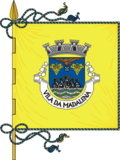Madalena, Azores
| Madalena | |||
| Municipality (Concelho) | |||
|
The vista off the coast of Madalena parish, showing the profile of the stratovolcano Pico and settlement of the municipal seat
|
|||
|
|||
| Official name: Concelho da Madalena do Pico | |||
| Name origin: Portuguese for Mary Magdalene | |||
| Country | |||
|---|---|---|---|
| Autonomous Region | |||
| Island | Pico | ||
| Civil Parishes | Bandeiras, Candelária, Criação Velha, Madalena, São Caetano, São Mateus | ||
| Landmark | Pico | ||
| Center | Areia Funda | ||
| - elevation | 12 m (39 ft) | ||
| - coordinates | 38°32′3″N 28°31′41″W / 38.53417°N 28.52806°WCoordinates: 38°32′3″N 28°31′41″W / 38.53417°N 28.52806°W | ||
| Highest point | Mount Pico | ||
| - elevation | 2,351 m (7,713 ft) | ||
| - coordinates | 38°28′6″N 28°23′56″W / 38.46833°N 28.39889°W | ||
| Lowest point | Sea level | ||
| - location | Atlantic Ocean | ||
| - elevation | 0 m (0 ft) | ||
| Area | 147.12 km2 (57 sq mi) | ||
| - water | .03 km2 (0 sq mi) | ||
| - urban | 17.38 km2 (7 sq mi) | ||
| Population | 6,049 (2011) | ||
| Density | 41/km2 (106/sq mi) | ||
| Settlement | fl. 1483 | ||
| - Municipality | 8 March 1723 | ||
| LAU | Câmara Municipal | ||
| - location | Largo Cardeal Costa Nunes | ||
| - elevation | 12 m (39 ft) | ||
| - coordinates | 38°32′5″N 28°31′36″W / 38.53472°N 28.52667°W | ||
| President | Jorge Manuel Pereira Rodrigues (PPD/PSD) | ||
| Municipal Chair | Álvaro José Alves Manito (PPD/PSD) | ||
| Timezone | Azores (UTC-1) | ||
| - summer (DST) | Azores (UTC0) | ||
| Postal Zone | 9950-324 | ||
| Area Code & Prefix | (+351) 292 XXX-XXXX | ||
| UNESCO World Heritage Site | |||
| Name | Landscape of the Pico Island Vineyard Culture | ||
| Year | 2004 (#28) | ||
| Number | 1117 | ||
| Region | Europe and North America | ||
| Criteria | (iii) (v) | ||
| Patron Saint | Santa Maria Madalena | ||
|
Location of the municipality of Madalena do Pico in the archipelago of the Azores
|
|||
| Website: http://www.cm-madalena.pt/ | |||
Madalena (Portuguese pronunciation: [mɐðɐˈlenɐ]) is a municipality along the western coast of the island of Pico, in the Portuguese Azores. The population in 2011 was 6,049, in an area of 147.12 km². The municipality is fronted by the stratovolcano Pico in the eastern frontier, and the Faial Channel which divides Pico from the island of Faial seven kilometers away. It is encircled almost entirely by the Atlantic Ocean except in the east, where it is bordered by São João (Lajes do Pico) in the southeast, and Santo António (São Roque do Pico) in the northeast.
The settlement of the island of Pico occurred much later than most islands, partly due to greater interest shown in the other islands of the Central Group. For a time, only small herds, deposited by property-owners from Faial and Terceira, along with their caretakers (some of whom were slaves), were the only inhabitants of the island. It was not until the Infanta Beatriz proceeded to reorganize island administration and promote a greater colonization of the islands of the Central Group (between 1470 and 1480) that this changed. In 1483, Faial and Pico were integrated into one Captaincy, under the Flem Josse van Huerter, and settlers were encouraged to colonize the island of Pico. But even still, the area of Madalena, with its rocky coastal plain, did not attract many new settlers and the community did not expand significantly until the municipality was created in 1723.
By the first quarter of the 18th century, the municipality of Madalena was already entrenched in the "wine cycle" which had multiplied the riches of its landowners and increased the desire of local settlers for emancipation from the Captaincy of Faial. The introduction of grapes to the island had occurred almost immediately with the first settlers, along with the cultivation of wheat and production of wine and olive oil (that were staples of the traditionally Mediterranean Christian culture at the time). In the 15th and 16th Century, the vineyards had been a source of subsistence, then export, because the soils and rocky terrain had made it almost impossible to develop a viable cereal culture. The diffusion of vineyards, that began in the 17th Century, was a consequence of the soil and the conquest of markets for Pico's verdelho wines. The uniquely Piquense culture of grape growing on the ground, or in volcanic rock patches, allowed the establishment of an industry and opened new markets for products originating in Madalena. In the second half of the 17th Century, the collapse of the woad industry, which supported many of the Azorean islands, and the decline of Iberian hegemony (Portugal was in a dynastic union with Spain at the time) in the North America, created a syndrome of crisis on the islands. The growth in viticulture onto better quality soils allowed an improvement of the castes, and a growth in the reputation and credibility of Piquense wines. In addition, new markets in North America and Brazil improved exports, which had primarily relied on English patronage and purchases.
...
Wikipedia




